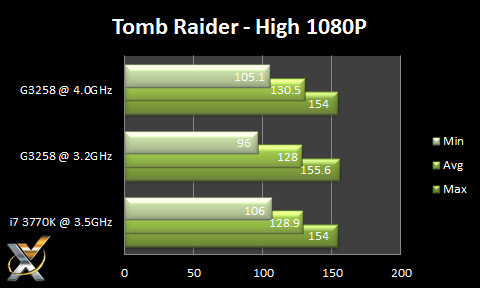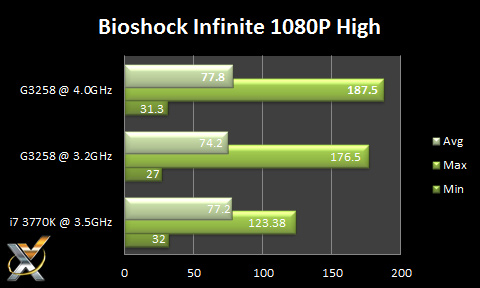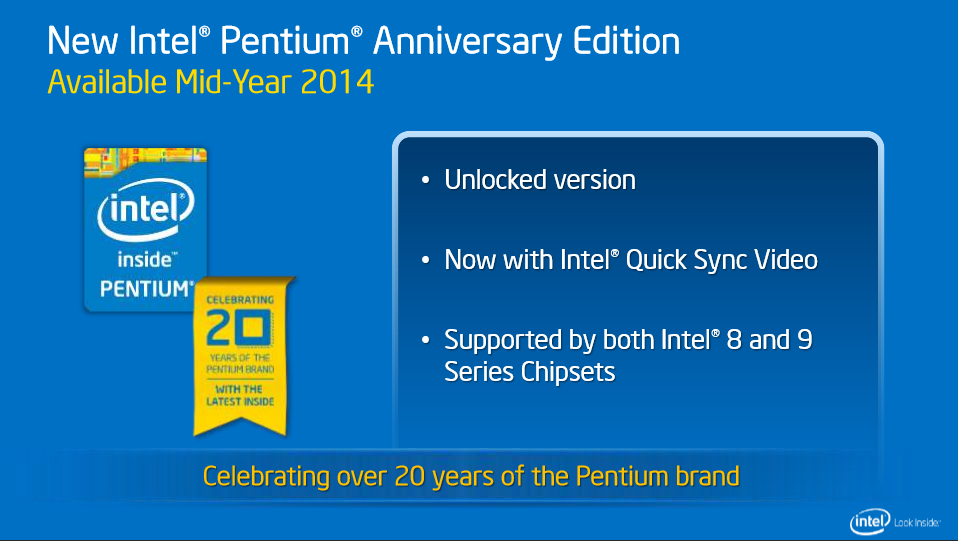TOMB RAIDER (2013)
Crystal Dynamic’s successful 2013 reboot of the Tomb Raider series is easily one of the most beautiful games released that year and it still competes graphically with many games released recently.
We’ll be testing it at 1080p “High” preset with FXAA anti-aliasing.
Ahh Tomb Raider, one of my favorite games in our benchmark suite, you can see that the overclock helps by raising the minimum up to 105 and the average by a few frames, both chips keep up very well with the i7, the overclocked run actually comes out faster than the i7.
BIOSHOCK INFINITE
The third installment of the Bioshock Franchise brings us to a brightly colored and beautifully stylized world. It isn’t the most graphically intensive game but it sure is purrty.
We’ll be testing it using the built in benchmarking tool at 1080p with the “Ultra” preset with DDoF (Dynamic Depth of Field) enabled.
As you can see in the benchmark the Pentium actually beats the i7 in at stock and @ 4GHz max frames but gets beat out in average and max FPS though the Pentium overclocked is the overall winner in everything but minimum FPS.
REPORT ANALYSIS AND FINAL THOUGHTS
Going over some final thoughts about the build as a whole, the original intent was to build a budget lan-box capable of doing some gaming and general use with room for future upgrades and overclocking and I will say the G3258, Cooler Master Elite 130 and MSI H97I AC performed remarkably, although the placement of the power supply makes it slightly difficult to install most aftermarket coolers most 140mm coolers should fit fine, besides the thing hit 4GHz ON THE STOCK COOLER. Keep on the look out for more coverage on these items as well.
The G3258 is not based on Intel’s Haswell Refresh or Devil’s Canyon architecture, which is a mid-life refresh of it’s 4th generation Haswell architecture. It unfortunately loses out on all of the enhancements made to the thermal interface material (TIM) that you’d find in the 4690K and 4790K parts which means you won’t be able to overclock as well, But I didn’t have too many problems partly because it’s only a dual core.
So all in all, I was quite impressed with this chip. It performed almost as well as my i7 in many gaming scenarios outside of Battlefield and very demanding games, but for those looking to play those games, the AMD FX 6300 is only around $30 more and would be a better fit. However, most games aren’t that CPU hungry and in lightly threaded games, which is most of them, it performed amazingly.
This new Pentium also allows someone on a budget the ability to upgrade to an i5 or i7 in the future which is very nice for budget oriented builds and builders. The strength of the CPU lies in it’s ability to perform one or two tasks very well and draw very little power doing so. Those looking to multitask or use in a productivity system should look elsewhere, but put in a entry level system with a decent graphics card and you will be in for a treat.
I give it my personal recommendation and think it has great value in comparison to the AMD A10’s and Athlon 760 and 750k when putting in a dedicated GPU and I’m very happy Intel has brought back a overclockable chip under $200.
Review Overview
Performance
Overclocking
Price
Features
Warranty
Very solid Bang for the Buck
Although it has its flaws, The Pentium Anniversary is one of the best budget CPUs available especially with the addition of non Z97 overclocking, It performs well in lightly threaded tasks and most games.
 Technology X Tomorrow's Technology Today!
Technology X Tomorrow's Technology Today!




Nice review fggt
This review helped a bunch thanks!
Sweet review! I agree with spending the extra $30 and going AMD.
Thank’s a lot of the comment. and have a great day!
Err, that last sentence on the first page. I have to say, the FX 6300 may be more expensive, but it leaves that Pentium in the dust on multi-threaded applications. The comparable chip to the Pentium would be the 760K or 860K, which are only $10-$20 more.
The reason I mention the FX 6300 is that it does much a better job at what it does, the 760K or 860K don’t have upgrade options. Thanks for your feedback and have a wonderful day!
I went from intel to amd and back to intel, and the biggest difference to me was reliability and responsiveness. I don’t think ill ever go back to amd processors, you pay for what you get rings true for me on this occasion
‘Responsiveness’
This one is a bit confusing to me, as I know what the word means but don’t completely understand your meaning. I’d consider all modern processors to be quite “responsive” in day to day tasks, and unless you’re doing heavy workloads, it is difficult to tell one processor from another. If we’re talking about performance, the Intel’s generally do win-out, but for an added price, which usually goes without saying.
‘Reliability’
This one is also odd, while I understand how stressful computer-related issues can be, I have found in my experience that they are very linked to the processor. Unless your CPU (any CPU) is overheating due to insufficient cooling, or is unstable due to heavy overclocking, it is rare for it to be unreliable. What i mean by that is, for the most part a processor either works as it should or doesn’t work at all.
With all that said, if you’ve had better experiences with Intel and prefer what they offer, by all means you should definitely stick with what you know. But, I would never count any single company out of the occasion based on an anecdotal experience.